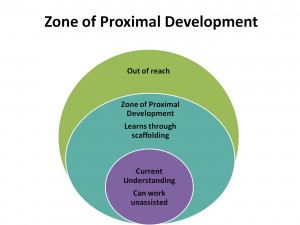Lev Vygotsky’s work has become the foundation of much research and theory in cognitive development. Vygotsky’s theories emphasize the role of social interaction in cognitive development as he believed that social interaction plays a key role in the process of making meaning.
Zone of Proximal Development
 “The zone of proximal development defines functions that have not matured yet, but are in a process of maturing, that will mature tomorrow, that are currently in an embryonic state; these functions could be called the buds of development, the flowers of development, rather than the fruits of development, that is, what is only just maturing” (Vygotsky in Bozhovich, 2009).
“The zone of proximal development defines functions that have not matured yet, but are in a process of maturing, that will mature tomorrow, that are currently in an embryonic state; these functions could be called the buds of development, the flowers of development, rather than the fruits of development, that is, what is only just maturing” (Vygotsky in Bozhovich, 2009).
Developed by Vygotsky, the concept of the Zone of Proximal Development (ZPD) describes the area between a child’s level of independent performance (what he/she can do alone) and the child’s level of assisted performance (what he/she can do with support). A child’s skills and understanding could emerge if the child engages in interactions with knowledgeable others (peers and adults) or in other supportive contexts in the ZPD. Instruction is effective when it is aimed within the ZPD and not at the child’s current level of independent performance. 
To determine an individual’s ZPD, the educator needs to know the current skill/developmental level and what skills/concepts will develop next. Understanding the developmental trajectories for skills/concepts is imperative if instruction is to be successful. Successful instruction within the ZPD enables the individual to independently function at the new level without assistance. Once this is accomplished, the educator can determine the new ZPD at which to focus instruction.
For most people, the transition from assisted to independent learning is a gradual process. Even when new skills and competencies have developed enough to perform a task with assistance, they will unlikely be ready to perform the task independently. Skill/concept acquisition involves moving from requiring a great deal of assistance, to doing more unassisted, to eventually requiring no assistance. To facilitate this transition, the educator provides and withdraws appropriate amounts of assistance at appropriate times. This facilitation is called scaffolding.
Scaffolding is used to progressively move a learner toward greater understanding and independence in the learning process. As the term implies, scaffolding provides temporary support for the learner to reach higher levels of understanding than they would be able to achieve without the assistance. Strategies that educators (or other experts) can use to scaffold a learner to the next level may include prompts, hints, cues, and questions, make-believe, or introducing tools or behaviours to assist the learner in mastering a new skill or concept.
Here are two short videos demonstrating Vgotsky’s theories. The first video demonstrates the Zone of Proximal Development and scaffolding; the second video shows how his theory applies to play.
Speech and Language Development
Vygotsky believed speech begins as a means of communication and socializing; later it becomes a tool of thinking. His research identified four broad stages in thought-language development.
- The first stage is the primitive (or natural) stage. This is the first major stage and is often referred to as ‘preintellectual’. It begins with a baby’s first sounds (crying, cooing, etc) and is at the level of behaviour. This early preverbal speech is how the infant communicates, expresses itself, and connects socially with others.
- The second stage is “naive psychology”. In this stage the child learns how to say words before their meaning is learned. An example of this is “dog”. For a child in this stage a “dog” can refer to a variety of things (“there is a dog”, ” where is the dog”, “is that a dog”). As the child develops and gains understanding of words, s/he begins to use them in short , “naive” sentences like “where dog?”. The child in this stage does not understand how to properly construct a sentence but does understand that saying the words in a certain way has meaning for others.
- The third stage is external speech. During this stage the child begins to use external objects to solve problems and represent words. An example of this would be a child using their fingers to count. Egocentric speech begins in this stage. Egocentric speech is the child’s verbalization of thought during play with others as well as when they are alone.
- The fourth stage is the ingrowth stage, the final stage in thought-language development. In this stage the child will use the skills they have acquired to perform tasks internally. For example, a child will now ‘count in their head’, or talk to themselves but not out loud (inner speech). As a child becomes more practiced with these new skills the more the skills will be used allowing the child to perform more proficiently.
Written language can only appear after a child has mastered inner speech as it requires the translation of thoughts into words. Furthermore, there is thought that must take the reverse course (idea transformed into inner speech then vocalized) prior to being communicated as the thought cannot be reduce to a word-image.
References
Atodd117. (2009, 04, 24). Charlie demonstrates Vyogtsky 0001. Retrieved from https://www.youtube.com/watch?v=ibEP4xBdJco
Blunden, A. (1997). Vygotsky and the dialectical method. Retrieved from https://www.marxists.org/archive/vygotsky/works/comment/vygotsk1.htm
Bozhovich. E.D. (2009). Zone of proximal development: The diagnostic capabilities and limitations of indirect collaboration. Journal of Russian and East European Psychology, 47 (6), 48-69.
Davidson Films, Inc. (2011, 06, 24). Play: A Vygotskian approach. Retrieved from https://www.youtube.com/watch?v=bulTeiHu8ME&list=UUnljspBdY19E69f_qWnOlPA
Davidson Films, Inc. (2010, 06, 11). Vygotsky’s developmental theory: An introduction. Retrieved from https://www.youtube.com/watch?v=InzmZtHuZPY&list=UUnljspBdY19E69f_qWnOlPA
Puntambeker, S. (2009). Scaffolding.Punambeker, S. (2009, November 23). Scaffolding. Retrieved November 10, 2014, from http://www.education.com/reference/article/scaffolding/#A
Zaretskii. V.K. (2009). The zone of proximal development: What Vygotsky did not have time to write. Journal of Russian and East European Psychology, 47 (6), 70-93.